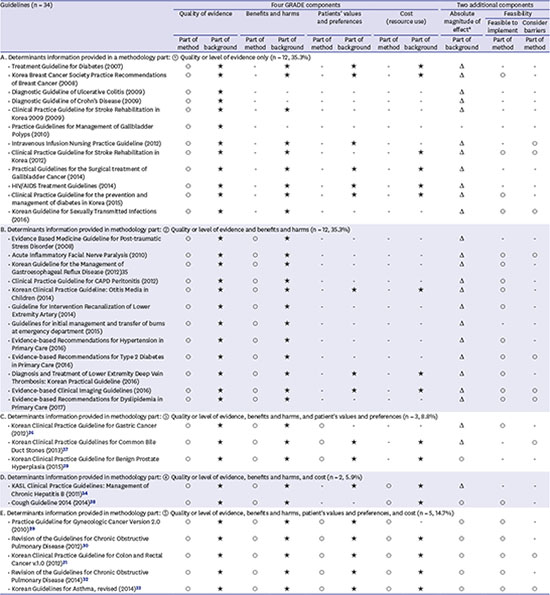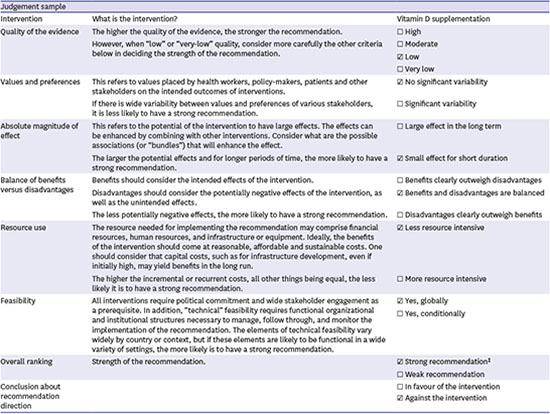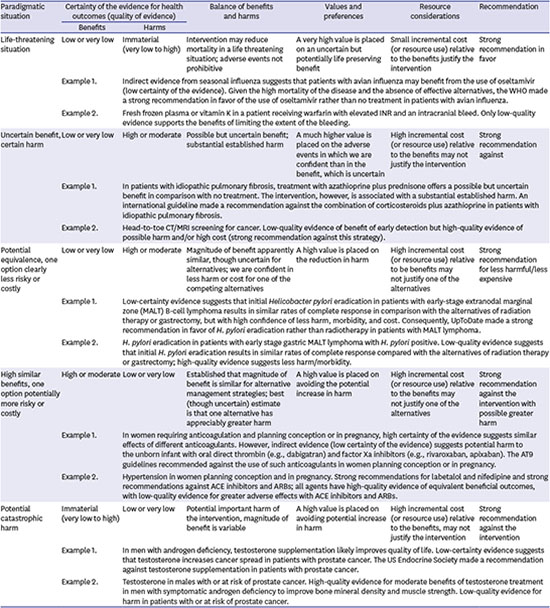1. Cuello García CA, Pacheco Alvarado KP, Pérez Gaxiola G. Grading recommendations in clinical practice guidelines: randomised experimental evaluation of four different systems. Arch Dis Child. 2011; 96(8):723–728.
2. Atkins D, Eccles M, Flottorp S, Guyatt GH, Henry D, Hill S, et al. Systems for grading the quality of evidence and the strength of recommendations I: critical appraisal of existing approaches the GRADE Working Group. BMC Health Serv Res. 2004; 4(1):38.

3. Seo KH, Lee SH, Shin ES, Lim SM, Jang JE, Jung YM, et al. Trend analysis of grading systems for level of evidence and strength of recommendation. J Korean Med Assoc. 2011; 54(7):758–768.

4. Guyatt GH, Oxman AD, Vist GE, Kunz R, Falck-Ytter Y, Alonso-Coello P, et al. GRADE: an emerging consensus on rating quality of evidence and strength of recommendations. BMJ. 2008; 336(7650):924–926.

5. Atkins D, Briss PA, Eccles M, Flottorp S, Guyatt GH, Harbour RT, et al. Systems for grading the quality of evidence and the strength of recommendations II: pilot study of a new system. BMC Health Serv Res. 2005; 5(1):25.

6. Mustafa RA, Santesso N, Brozek J, Akl EA, Walter SD, Norman G, et al. The GRADE approach is reproducible in assessing the quality of evidence of quantitative evidence syntheses. J Clin Epidemiol. 2013; 66(7):736–742.

7. Nasser SM, Cooke G, Kranzer K, Norris SL, Olliaro P, Ford N. Strength of recommendations in WHO guidelines using GRADE was associated with uptake in national policy. J Clin Epidemiol. 2015; 68(6):703–707.

8. Thornton J, Alderson P, Tan T, Turner C, Latchem S, Shaw E, et al. Introducing GRADE across the NICE clinical guideline program. J Clin Epidemiol. 2013; 66(2):124–131.

9. Al-Hameed F, Al-Dorzi HM, Shamy A, Qadi A, Bakhsh E, Aboelnazar E, et al. The Saudi clinical practice guideline for the diagnosis of the first deep venous thrombosis of the lower extremity. Ann Thorac Med. 2015; 10(1):3–15.
10. Kavanagh BP. The GRADE system for rating clinical guidelines. PLoS Med. 2009; 6(9):e1000094.

11. Schünemann HJ, Jaeschke R, Cook DJ, Bria WF, El-Solh AA, Ernst A, et al. An official ATS statement: grading the quality of evidence and strength of recommendations in ATS guidelines and recommendations. Am J Respir Crit Care Med. 2006; 174(5):605–614.

12. Guyatt GH, Oxman AD, Kunz R, Falck-Ytter Y, Vist GE, Liberati A, et al. Going from evidence to recommendations. BMJ. 2008; 336(7652):1049–1051.

13. Andrews J, Guyatt G, Oxman AD, Alderson P, Dahm P, Falck-Ytter Y, et al. GRADE guidelines: 14. Going from evidence to recommendations: the significance and presentation of recommendations. J Clin Epidemiol. 2013; 66(7):719–725.

14. Andrews JC, Schünemann HJ, Oxman AD, Pottie K, Meerpohl JJ, Coello PA, et al. GRADE guidelines: 15. Going from evidence to recommendation-determinants of a recommendation's direction and strength. J Clin Epidemiol. 2013; 66(7):726–735.

15. Brożek JL, Akl EA, Compalati E, Kreis J, Terracciano L, Fiocchi A, et al. Grading quality of evidence and strength of recommendations in clinical practice guidelines part 3 of 3. The GRADE approach to developing recommendations. Allergy. 2011; 66(5):588–595.

16. Atkins D, Best D, Briss PA, Eccles M, Falck-Ytter Y, Flottorp S, et al. Grading quality of evidence and strength of recommendations. BMJ. 2004; 328(7454):1490.

17. Brozek JL, Akl EA, Alonso-Coello P, Lang D, Jaeschke R, Williams JW, et al. Grading quality of evidence and strength of recommendations in clinical practice guidelines. Part 1 of 3. An overview of the GRADE approach and grading quality of evidence about interventions. Allergy. 2009; 64(5):669–677.
18. Guyatt G, Oxman AD, Akl EA, Kunz R, Vist G, Brozek J, et al. GRADE guidelines: 1. Introduction-GRADE evidence profiles and summary of findings tables. J Clin Epidemiol. 2011; 64(4):383–394.

19. Guyatt G, Oxman AD, Sultan S, Brozek J, Glasziou P, Alonso-Coello P, et al. GRADE guidelines: 11. Making an overall rating of confidence in effect estimates for a single outcome and for all outcomes. J Clin Epidemiol. 2013; 66(2):151–157.

20. Balshem H, Helfand M, Schünemann HJ, Oxman AD, Kunz R, Brozek J, et al. GRADE guidelines: 3. Rating the quality of evidence. J Clin Epidemiol. 2011; 64(4):401–406.

21. Guyatt GH, Oxman AD, Kunz R, Vist GE, Falck-Ytter Y, Schünemann HJ, et al. What is “quality of evidence” and why is it important to clinicians? BMJ. 2008; 336(7651):995–998.

22. Fraenkel L. Incorporating patients' preferences into medical decision making. Med Care Res Rev. 2013; 70(1):Suppl. 80S–93S.

23. Brunetti M, Shemilt I, Pregno S, Vale L, Oxman AD, Lord J, et al. GRADE guidelines: 10. Considering resource use and rating the quality of economic evidence. J Clin Epidemiol. 2013; 66(2):140–150.

24. Guyatt GH, Oxman AD, Kunz R, Jaeschke R, Helfand M, Liberati A, et al. Incorporating considerations of resources use into grading recommendations. BMJ. 2008; 336(7654):1170–1173.

25. Neumann I, Santesso N, Akl EA, Rind DM, Vandvik PO, Alonso-Coello P, et al. A guide for health professionals to interpret and use recommendations in guidelines developed with the GRADE approach. J Clin Epidemiol. 2016; 72:45–55.

26. Alexander PE, Bero L, Montori VM, Brito JP, Stoltzfus R, Djulbegovic B, et al. World Health Organization recommendations are often strong based on low confidence in effect estimates. J Clin Epidemiol. 2014; 67(6):629–634.

27. Alexander PE, Brito JP, Neumann I, Gionfriddo MR, Bero L, Djulbegovic B, et al. World Health Organization strong recommendations based on low-quality evidence (study quality) are frequent and often inconsistent with GRADE guidance. J Clin Epidemiol. 2016; 72:98–106.

28. Alexander PE, Gionfriddo MR, Li SA, Bero L, Stoltzfus RJ, Neumann I, et al. A number of factors explain why WHO guideline developers make strong recommendations inconsistent with GRADE guidance. J Clin Epidemiol. 2016; 70:111–122.

29. The Korean Society of Gynecologic Oncology. Korean Academy of Medical Sciences. Practice Guideline for Gynecologic Cancer Version 2.0. Seoul, Korea: The Korean Society of Gynecologic Oncology;2010.
30. The Korean Academy of Tuberculosis and Respiratory Diseases. Revision of the Guidelines for Chronic Obstructive Pulmonary Disease 2012. Seoul, Korea: The Korean Academy of Tuberculosis and Respiratory Diseases;2012.
31. Korean Academy of Medical Sciences. Korean Clinical Practice Guideline for Colon and Rectal Cancer v.1.0. Seoul, Korea: Korean Academy of Medical Sciences;2012.
32. The Korean Academy of Tuberculosis and Respiratory Diseases. Revision of the Guidelines for Chronic Obstructive Pulmonary Disease 2014. Seoul, Korea: The Korean Academy of Tuberculosis and Respiratory Diseases;2014.
33. The Korean Academy of Tuberculosis and Respiratory Diseases. Korean Guidelines for Asthma, Revised 2014. Seoul, Korea: The Korean Academy of Tuberculosis and Respiratory Diseases;2014.
34. The Korean Association for the Study of the Liver. KASL Clinical Practice Guidelines: Management of Chronic Hepatitis B. Seoul, Korea: The Korean Association for the Study of the Liver;2011.
35. The Korean Society of Neurogastroenterology and Motility. Korean Guideline for the Management of Gastroesophageal Reflux Disease. Seoul, Korea: The Korean Society of Neurogastroenterology and Motility;2012.
36. Korean Academy of Medical Sciences. Korean Clinical Practice Guideline for Gastric Cancer. Seoul, Korea: Korean Academy of Medical Sciences;2012.
37. Korean Pancreatobiliary Association. Korean Clinical Practice Guidelines for Common Bile Duct Stones. Seoul, Korea: Korean Pancreatobiliary Association;2013.
38. The Korean Academy of Tuberculosis and Respiratory Diseases. Cough Guideline. Seoul, Korea: The Korean Academy of Tuberculosis and Respiratory Diseases;2014.
39. The Korean Urological Association. The Korean Academy of Family Medicine. Korean Continence Society. Korean Clinical Practice Guideline for Benign Prostate Hyperplasia. Seoul, Korea: The Korean Urological Association;2015.
40. Korean Academy of Medical Sciences. Korea Centers for Disease Control and Prevention. Development and Dissemination of CPGs for Chronic Diseases. Seoul, Korea: Korean Academy of Medical Sciences;2013.









 PDF
PDF Citation
Citation Print
Print







 XML Download
XML Download